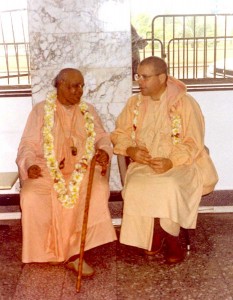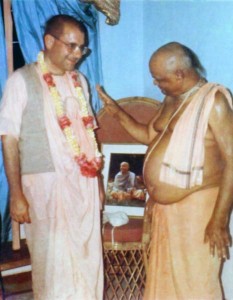Among the many moonlike devotees of Srila Prabhupada, Srila Gour Govinda Swami Maharaja shines brilliantly in the firmament, illuminating the hearts and lives of those who come into his light.
Today we are observing the twentieth anniversary of Maharaja’s divine departure, on Srila Bhaktisiddhanta Sarasvati Thakura’s appearance day in Mayapur, February 9, 1996. I had left Mayapur earlier that day, after placing my head on Maharaja’s lotus feet and receiving his affectionate blessing. As I learned later, that afternoon Bhaktarupa Prabhu and two senior lady devotees came to meet Maharaja in his room, and they inquired of him about Krishna—why Lord Chaitanya made his base in Puri, what was the relationship between Lord Jagannatha and Vrindavan. Maharaja enthusiastically narrated the pastimes of Krishna and how Krishna, having been in separation from Radharani, assumed the form of Jagannatha. Because of Maharaja’s exalted Krishna consciousness, he felt transcendental ecstasy remembering and narrating Krishna’s pastimes. And in this case he became overwhelmed, and he excused himself, saying that he was unable to speak more. He lay back on his bed and, gazing at a picture of his worshipable Deity Gopal Jiu, while devotees chanted the holy names, in a deep state of Krishna consciousness, he left this world.
In Srimad-Bhagavatam (4.28.47) Srila Prabhupada discusses the departure of the spiritual master: “[W]hen the mortal body of the spiritual master expires, his disciples should cry exactly as the queen cries when the king leaves his body. However, the disciple and spiritual master are never separated, because the spiritual master always keeps company with the disciple as long as the disciple follows strictly the instructions of the spiritual master. This is called the association of vani (words). Physical presence is called vapuh. As long as the spiritual master is physically present, the disciple should serve the physical body of the spiritual master, and when the spiritual master is no longer physically existing, the disciple should serve the instructions of the spiritual master.”
Devotees cried for Srila Gour Govinda Swami Maharaja when he left, and we should cry for him now—for his mercy—and be eager to hear from him, as he instructed: “All sadhus speak through their books. Jiva Gosvami, Rupa Gosvami, Sanatana Gosvami, Bhaktivinoda Thakura, Bhaktisiddhanta Sarasvati, and Srila Prabhupada all say that they speak through books. . . . This is our Vaishnava procedure. But you should see him. . . . You may say, ‘Oh, I have read their books, I have their association.’ . . . You cannot understand what they have said merely by reading their books.”
Once, when Maharaja came to Mauritius, after he gave a class at the ISKCON Vedic Farm in Bon Accueil, I mentioned to him the verses in Sri Caitanya-caritamrta(Madhya 22.128–129) about the five most potent forms of devotional service:
sadhu-sanga, nama-kirtana, bhagavata-sravana
mathura-vasa, sri-murtira sraddhaya sevana
“One should associate with devotees, chant the holy name of the Lord, hear Srimad-Bhagavatam, reside at Mathura, and worship the Deity with faith and veneration.
sakala-sadhana-srestha ei panca anga
krsna-prema janmaya ei pancera alpa sanga
“These five limbs of devotional service are the best of all. Even a slight performance of these five awakens love for Krsna.”
I told him how much I cherished mathura-vasa, residing in Mathura (or Vrindavan). Maharaja looked me straight in the eyes and said, “Kamsa also resided in Mathura, but still he was a demon.” Immediately I realized that yes, one can reside in Mathura, but he must also give up the demonic mentality of wanting to be the Supreme—the proprietor, the controller, and the enjoyer. Externally one may reside in Mathura, but internally he must do the work of purifying the heart.
Maharaja spoke these words to me with great love and compassion. I felt that he was seeing straight into my polluted heart and acting to purify it. He instructed me that the goal was not to reside in Mathura but to actually develop the consciousness of a devotee. And we can see from this example that the direct, personal association of a sadhu is required to understand the real import, or purport, of the books we read, of scripture.
The sadhus speaking through their books “are very, very merciful,” Maharaja said, “but you should follow the proper path. If you are intelligent you will understand how they are still here, not only in the form of their books, but also they are here. You should see them. . . . If you can get his mercy then you can see him. Otherwise, by your own effort and perception you cannot see him. No, no, no. You always think that you are drasta, the seer, and that the sadhu is drsta, the one to be seen. Everyone is like this. They think they are the seers. But it is just the reverse. You are to be seen and they are the seer.” And when a devotee asked him, “How are we seen by the sadhu—by our service?” Maharaja replied, “Yes. The sadhu is the seer. If he showers his mercy upon you, he sees you. If you receive that merciful glance then you are very fortunate.”
Part of Maharaja’s mission was to show that everything is in Srila Prabhupada’s books. He said that they are like an ocean filled with gems and that to gather those gems one must dive very deep. Maharaja’s own books include talks based on Srila Prabhupada’s books, revealing many beautiful gems there and showing how one can get the highest realizations of Krishna consciousness from them—sambandha, abhideya, and prayojana: what our relationship with Krishna is, how to act in that relationship, and how to actually realize life’s ultimate goal, pure love for Krishna, krsna-prema. We should also dive deep into Maharaja’s books and mine the priceless gems he has kept for us there.
After Maharaja’s passing I was unable to visit Mayapur for some years, and when I finally returned I was most eager to visit the newly constructed samadhis of my dear departed godbrothers—Tamal Krishna Goswami, Sridhar Swami, Bhakti Tirtha Swami, and Gour Govinda Swami. When I offered my obeisance at Srila Gour Govinda Swami’s samadhi, I felt that he gave me a direct instruction: “Do not judge others. You do not know what devotion they have in their hearts.” In other words, I am not the seer of the sadhus; I am meant to be seen by them.
On this occasion, I pray to Srila Gour Govinda Swami Swami Maharaja that by his grace he always keep me under his shelter, instruct me and rectify me without reservation or hesitation, and engage me in service to him, Srila Prabhupada, our parampara, and their mission.
Hare Krishna.


Comments